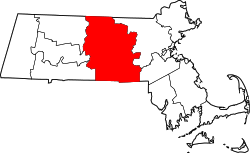Dana, Massachusetts | |
|---|---|
Former town | |
 Site of Dana Common | |
 | |
| Interactive map of Dana, Massachusetts | |
| Coordinates: 42°25′19″N72°13′39″W / 42.42194°N 72.22750°W | |
| Country | United States |
| State | Massachusetts |
| County | Worcester |
| Settled | 1676 |
| Incorporated | February 18, 1801 |
| Disincorporated | April 28, 1938 |
| Time zone | UTC-5 (Eastern) |
| • Summer (DST) | Eastern |
| Designated | March 4, 2013 |
| Reference no. | 13000052 [1] |
Dana was a town located in Worcester County, Massachusetts, United States. Dana was lost as a result of the formation of the Quabbin Reservoir.







